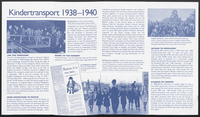Overview
- Brief Narrative
- Iron Cross (Eisernes Kreuz) second class medal and ribbon, awarded to a member of Dorothy Fried Goldmeier’s family, for bravery as a soldier in the German Army during World War I (1914-1918). The Iron Cross was first issued in 1813 and reissued in August 1914, after the start of World War I. It was awarded to servicemen of all ranks, and as many as 5,000,000 second class medals were awarded between 1914 and 1918. Although it was originally a Prussian award, its use continued after German unification. Even after Germany lost World War I, the Iron Cross remained a symbol of military honor and pride. Dorothy’s father, Hans Friedlander (later John Fried, 1898-1980), and his brother, Wilhelm (later Willy Fried, 1895-1991), were raised in Breslau, Germany (now Wroclaw, Poland), and served in the German military during World War I. On April 14, 1927, Hans sailed for the United States, and Americanized his name to John Fried. On July 17, 1930, John married Hedwig (Hede) Nakler (1901-1983) in Grantwood, New York. Hede was born in Stettin, Germany, and immigrated to the US with her sister, Erna (1899-1993), in January 1927. Hede and Erna’s brother, Manfred (1897-1917), died following an injury in World War I, and earned a posthumous Iron Cross for his service.
- Date
-
issue:
1914 August 05-1918
received: after 1914 August 05-before 1918 November 11
- Geography
-
manufacture:
Germany
- Credit Line
- United States Holocaust Memorial Museum Collection, Gift of Karen Goldmeier Green
- Markings
- a. front, center, embossed : (crown) / W / 1914 [Wilhelm]
a. back, center, embossed : (crown) / FW / 1813 [Friedrich Wilhelm]
a. bail, medal, maker’s mark, stamped : EW
Physical Details
- Classification
-
Awards
- Category
-
Medals
- Object Type
-
Medals, German (lcsh)
- Genre/Form
- Medals.
- Physical Description
- a. Black painted, iron alloy, cross pattée medal with flared ends and a silver-plated outer border with a reeded inner line border. The front and back have an embossed design arranged in a central column. The front design has a crown at the top, the Royal Cipher (W) at the center, and the year the medal was reinstated at the bottom. The back design has a crown above the Royal Cipher (FW) at the top, followed by a sprig of three oak leaves with two acorns in the center, and the year the medal was first issued at the bottom. A suspension ring with a large bail is attached to the center of the upper arm. Threaded through the bail is a black and white striped grosgrain ribbon (b). The silver border is tarnished throughout.
b. A grosgrain ribbon for an iron cross medal (a) with five vertical stripes: a wide black center flanked by white stripes and narrow black edges. The ribbon has been threaded through the bail of the medal. The ends are cut, frayed, and worn, with a small brown stain midway up one side. There are several pinholes near each end of the ribbon. - Dimensions
- a: Height: 2.625 inches (6.668 cm) | Width: 1.750 inches (4.445 cm) | Depth: 0.125 inches (0.318 cm)
b: Height: 12.250 inches (31.115 cm) | Width: 1.250 inches (3.175 cm) - Materials
- a : iron alloy, silver, paint
b : ribbon
Rights & Restrictions
- Conditions on Access
- No restrictions on access
- Conditions on Use
- No restrictions on use
Keywords & Subjects
Administrative Notes
- Legal Status
- Permanent Collection
- Provenance
- The medal was donated to the United States Holocaust Memorial Museum in 2014 by Karen Goldmeier Green, the granddaughter of John Fried.
- Funding Note
- The cataloging of this artifact has been supported by a grant from the Conference on Jewish Material Claims Against Germany.
- Record last modified:
- 2023-08-25 08:13:41
- This page:
- https://collections.ushmm.org/search/catalog/irn85375
Download & Licensing
In-Person Research
- By Appointment
- Request 21 Days in Advance of Visit
- Plan a Research Visit
- Request to See This Object
Contact Us
Also in John and Dorothy Goldmeier collection
The collection consists of a World War I medal, documents, and photograph albums relating to the experiences of Hans Goldmeier (later John), his wife, Dorothy Fried Goldmeier, and their extended families in Germany and England before, during, and after World War II.
Date: 1900-2005

John and Dorothy Fried Goldmeier papers
Document
This collection relates to Hans (John) Goldmeier, who was sent from Germany to England at age 10. Though his older brother emigrated with him, and parents later followed, John was separated from them (due to work, school, and the death of his father) for the majority of the war. He formed strong bonds with those caring for him and his schoolmates at the Stoatley Rough boarding school, many of whom were also Jewish refugees. The collection highlights include John’s schoolwork at Stoatley Rough, where he reflected on the war and his own refugee status, and many reminiscences of other “Roughians” at the many post-war reunions that were held. The collection also includes smaller collections of documents, German passports (Reisepass), and photographs related to the Nakler and Friedländer families documenting their lives in Germany, World War I, and emigration. Both Hede Nakler and Willy Fried (John’s brother) gave oral history interviews on audiotape, which are also included in the collection. The Friedländer family is distantly related to the family of Arthur Kronthal who put together a family tree and narrative entitled “A Jewish Life From the Last Century” which is also included in this collection. Please see also 2006.18, the Goldmeier family records, for related family material.
Oral history interview with Willy Fried
Oral History
Oral history interview with Hede Nakler
Oral History



